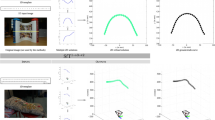Abstract
This paper describes a simple construction for building a combinatorial model of a smooth manifold-solid from a labeled-figure representing its occluding contour. The motivation is twofold. First, deriving the combinatorial model is an essential intermediate step in the visual reconstruction of solid-shape from image contours. A description of solid-shape consists of a metric and a topological component. Both are necessary: the metric component specifies how the topological component is embedded in three-dimensional space. The paneling construction described in this paper is a procedure for generating the topological component from a labeled-figure representing the occluding contour. Second, the existence of this construction establishes the sufficiency of a labeling scheme for line-drawings of smooth solid-objects originally proposed by Huffman (1971). By sufficiency, it is meant that every set of closed plane-curves satisfying this labeling scheme is shown to correspond to a generic view of a manifold-solid. Together with the Whitney theorem (Whitney, 1955), this confirms that Huffman's labeling scheme correctly distinguishes possible from impossible smooth solid-objects.
Similar content being viewed by others
References
Arnold, V. I. 1991. The Theory of Singularities and its Applications. Cambridge University Press: Cambridge.
Callahan, J. and Weiss, R. 1985. A model for describing surface shape. IEEE Conference on Computer Vision and Pattern Recognition, San Francisco, CA, pp. 240-245.
Draper, S. W. 1980. Reasoning about Depth in Line-Drawing Interpretation. Ph. D. Thesis, Sussex University.
Francis, G. K. and Troyer, S. F. 1977. Excellent maps with given folds and cusps. Houston Journal of Math., 3:165-194.
Griffiths, H. B. 1981. Surfaces, 2nd edition. Cambridge University Press: Cambridge.
Henle, M. 1979. A Combinatorial Introduction to Topology. W. H. Freeman and Co.: San Francisco, Cal.
Huffman, D. A. 1971. Impossible objects as nonsense sentences. Machine Intelligence 6, B. Meltzer and D. Michie (Eds.), American Elsevier Publishing Co.: New York.
Kanade, T. 1981. Recovery of the three-dimensional shape of an object from a single view. Artificial Intelligence, 17:409-460.
Kanizsa, G. 1979. Organization in Vision. Praeger: New York.
Koenderink, J. J. and van Doorn, A. J. 1976. The singularities of the visual mapping. Biological Cybernetics, 24.
Malik, J. 1987. Interpreting line drawings of curved objects. Intl. Journal of Computer Vision, 1(1):73-103.
Paul, G. S. 1988. Predatory Dinosaurs of the World: A Complete Illustrated Guide. Simon and Schuster: New York.
Pignoni, R. 1991. Onsurfaces and their contours. Manuscripta Math., 72:223-249.
Richards, W., Koenderink, J. J., and Huffman, D. D. 1988. Inferring 3Dshapes from2Dsilhouettes. Natural Computation, W. Richards (Ed.), MIT Press: Mass, Cambridge.
Seifert, H. and Threlfall. 1980. A Textbook of Topology. Academic Press: Mass., Boston.
Szeliski, R., Tonnesen, D., and Terzopolous, D. 1993. Modeling surfaces of arbitrary topology with dynamic particles. IEEE Conference on Computer Vision and Pattern Recognition, New York City.
Terzopolous, D., Witkin, A., and Kass, M. 1987. Symmetry-seeking models for 3D object reconstruction. Proc. of the 1st Intl. Conf. on Computer Vision, London, England.
Waltz, D. 1975. Understanding line drawings of scenes with shadows. Psychology of Computer Vision, P. H. Winston (Ed.). McGraw Hill: New York.
Whitney, H. 1955. On singularities of mappings of Euclidean spaces I: Mappings of the plane into the plane. Ann. of Math. 62.
Williams, L. R. 1994. Perceptual Completion of Occluded Surfaces. Ph. D. Dissertation, Dept. of Computer Science, University of Massachusetts, Mass, Amherst.
Williams, L. R. and Hanson, A. R. 1996. Perceptual completion of occluded surfaces. Computer Vision and Image Understanding 64:1-20.
Rights and permissions
About this article
Cite this article
Williams, L.R. Topological Reconstruction of a Smooth Manifold-Solid from Its Occluding Contour. International Journal of Computer Vision 23, 93–108 (1997). https://doi.org/10.1023/A:1007967925618
Issue Date:
DOI: https://doi.org/10.1023/A:1007967925618




